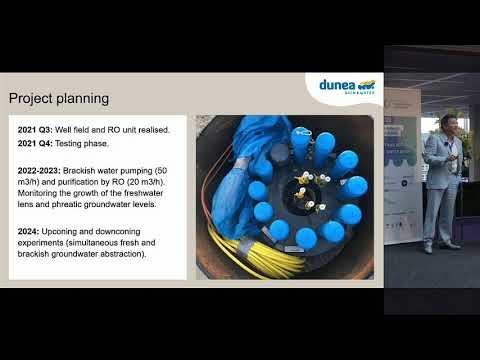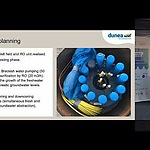One of the options is the use of brackish groundwater for drinking water production. Brackish groundwater is an excellent feed water for (low-pressure) reverse osmosis membranes, and can be desalinated at acceptable (energy) costs. Extracting brackish groundwater below the freshwater lens in the coastal dunes has a second advantage: deep-well extraction causes hydraulic (groundwater) heads to decrease, resulting in a downward shift of the fresh-brackish groundwater interface and an effective growth of the freshwater lens (Zuurbier et al., 2016). Brackish groundwater may thus provide an additional water source and extraction may result in an effective increase in Dunea’s strategic fresh groundwater reserves. These combined benefits of brackish water abstraction are referred to as the Freshman concept (see Figure).
To investigate the potential and optimization of the Freshman concept, a field pilot has been set up at Dunea’s primary drinking water production site in the coastal dunes of The Hague. For the pilot, a multi-screened abstraction well for brackish groundwater has been installed, along with an additional abstraction well for fresh groundwater, multiple monitoring wells, and a facility for collection and desalination of the abstracted brackish groundwater. The pilot will run for three years (2022-2024). The pilot will be used to better characterize the hydrogeology, increase our understanding of fresh-brackish groundwater interactions, validate model results, and to gain operational experience with brackish water desalination. Based on the results of the field test and follow-up modelling studies, Dunea will decide whether brackish groundwater indeed is a feasible drinking water source for the near future. If proven successful, the Freshman concept may be replicated in other coastal areas, where freshwater availability is limited and under increasing pressure due to sea level rise and increasing water demand.
Source: Zwolsman, G. 2021. The LIFE-Freshman project: Feasibility of brackish groundwater as additional drinking water source in the Dutch coastal zone. Additional drinking water sources and circular economy, Risk & Resilience. AIWW 2021.
In-person Conference

